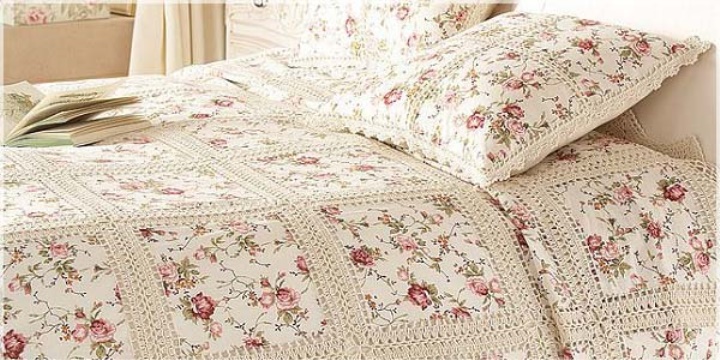
Materials used
This cover can be made from any fabric: thin cotton or denim and other material.
You can use different flaps and make a bright patchwork of squares. If you have accumulated a lot of old jeans, that's the perfect idea to make such a veil of jeans.
I can not even properly formulate the action, or sew, or tie it together?
My friend made such bedspreads even from old drape coats. Tied and crocheted squares of drape. It turned out very beautiful, unusual.
For tying the squares, acrylic or cotton yarn of color, combined with the color of the fabric, is suitable. The hook is selected with the appropriate thickness of the yarn number.
How to prepare squares from fabric for a cover
From the fabric chosen by us we cut the necessary quantity of squares of the same size.
Squares can be with a side of 12 cm or more. I would have made centimeters 20. Depending on the size of the future veil, we calculate how many squares in width and length will be required. On a blanket measuring 210x150 cm, approximately 352 squares measuring 12x12 cm will be required.
It facilitates the process of creating a blanket of squares in the proposed technique that no lining is required here.
Squares of a thin fabric with crumbling edges need to be cut out with allowances on the seams. The edges of the squares sew on the typewriter.
You can make a double-sided cover, in this case sew two squares together on the perimeter from the wrong side, leaving a small area through which to turn the square on the front side.
Squares of thick fabricno need to sew. But, before you tie them with a crochet, you need to mark out the punctures.
On the wrong side of the square at a distance of 0.5-0.9 cm from the edge, we draw a line with dry soap parallel to the edge. The thicker the fabric, the greater the distance from the edge.
Then, on this line, we make a marking of holes at a distance of 0.5-1.2 cm. The
markup must be started from the corner, then to the left, then to the right. In the middle of the side, you can adjust the distance between two or three holes, slightly increasing or decreasing it.
In the designated places, we make punctures with the help of an awl.
Tying the squares of the crochet
The next step in the production of covers from the squares tie them crochet.
Squares of thin fabric are tied with columns without a crochet at a short distance from each other. We begin to bind from the middle of the side. In the corners we knit three bars without a crochet.
On the squares of thick tissue, it is better to tie two or three pillars without a crochet in each punched hole, depending on the distance between the holes. In the corners in this case we knit 7 columns without a crochet. It is also possible, in principle, to tie up squares of fine fabric.
Choose the scheme we liked the edge of the binding and then tie the squares according to the scheme.
I offer you a small selection of schemes for strapping.